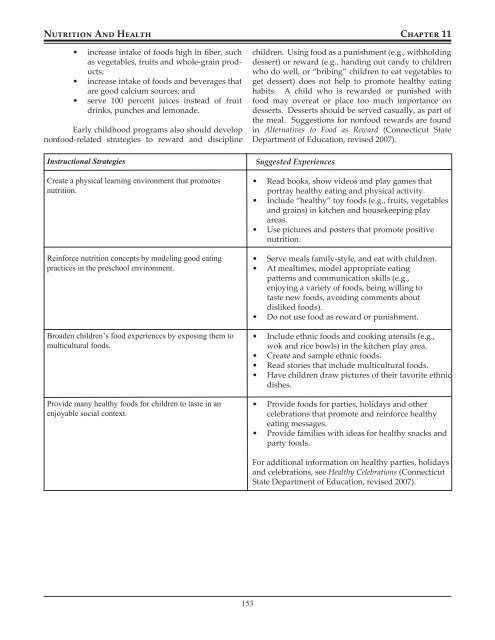Early Childhood - Connecticut State Department of Education
Early Childhood - Connecticut State Department of Education
Early Childhood - Connecticut State Department of Education
Create successful ePaper yourself
Turn your PDF publications into a flip-book with our unique Google optimized e-Paper software.
Nutrition And Health Chapter 11<br />
• increase intake <strong>of</strong> foods high in fiber, such<br />
as vegetables, fruits and whole-grain products;<br />
• increase intake <strong>of</strong> foods and beverages that<br />
are good calcium sources; and<br />
• serve 100 percent juices instead <strong>of</strong> fruit<br />
drinks, punches and lemonade.<br />
<strong>Early</strong> childhood programs also should develop<br />
nonfood-related strategies to reward and discipline<br />
Instructional Strategies<br />
Create a physical learning environment that promotes<br />
nutrition.<br />
Reinforce nutrition concepts by modeling good eating<br />
practices in the preschool environment.<br />
Broaden children’s food experiences by exposing them to<br />
multicultural foods.<br />
Provide many healthy foods for children to taste in an<br />
enjoyable social context.<br />
153<br />
children. Using food as a punishment (e.g., withholding<br />
dessert) or reward (e.g., handing out candy to children<br />
who do well, or “bribing” children to eat vegetables to<br />
get dessert) does not help to promote healthy eating<br />
habits. A child who is rewarded or punished with<br />
food may overeat or place too much importance on<br />
desserts. Desserts should be served casually, as part <strong>of</strong><br />
the meal. Suggestions for nonfood rewards are found<br />
in Alternatives to Food as Reward (<strong>Connecticut</strong> <strong>State</strong><br />
<strong>Department</strong> <strong>of</strong> <strong>Education</strong>, revised 2007).<br />
Suggested Experiences<br />
• Read books, show videos and play games that<br />
portray healthy eating and physical activity.<br />
• Include “healthy” toy foods (e.g., fruits, vegetables<br />
and grains) in kitchen and housekeeping play<br />
areas.<br />
• Use pictures and posters that promote positive<br />
nutrition.<br />
• Serve meals family-style, and eat with children.<br />
• At mealtimes, model appropriate eating<br />
patterns and communication skills (e.g.,<br />
enjoying a variety <strong>of</strong> foods, being willing to<br />
taste new foods, avoiding comments about<br />
disliked foods).<br />
• Do not use food as reward or punishment.<br />
• Include ethnic foods and cooking utensils (e.g.,<br />
wok and rice bowls) in the kitchen play area.<br />
• Create and sample ethnic foods.<br />
• Read stories that include multicultural foods.<br />
• Have children draw pictures <strong>of</strong> their favorite ethnic<br />
dishes.<br />
• Provide foods for parties, holidays and other<br />
celebrations that promote and reinforce healthy<br />
eating messages.<br />
• Provide families with ideas for healthy snacks and<br />
party foods.<br />
For additional information on healthy parties, holidays<br />
and celebrations, see Healthy Celebrations (<strong>Connecticut</strong><br />
<strong>State</strong> <strong>Department</strong> <strong>of</strong> <strong>Education</strong>, revised 2007).

















